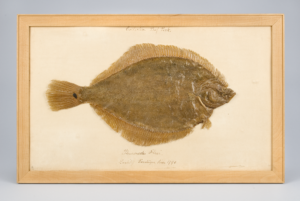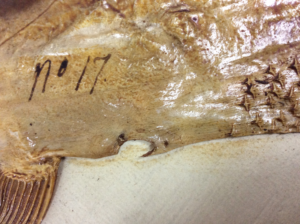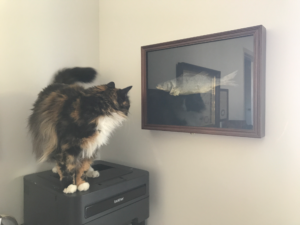The dried skin of a fish hangs over my head as I type. It has been there for nearly two years, and no longer smells as it did for weeks after I slit the animal in half (fig. 1). This sea bass from the grocery store, now a specimen, was my attempt to understand a widespread but little-remembered practice in eighteenth-century science that might seem strange to us today: to dry, bisect, and flatten animals like fish, and then glue or stitch them on paper or slip them in books like pressed flowers (fig. 2).
In the 1740s, a Dutch botanist named John Frederick Gronovius published a set of fish flattening instructions in the Philosophical Transactions of London’s premier scientific collective, the Royal Society. Many more naturalists would publish variant recipes. According to Gronovius, one would cut the animal in half from head to tail with “Scissars,” remove its innards and flesh, keep the tail and fins expanded with pins while the fish dried in the sun or near a fire, and press the skin for a full twenty-four hours. When American naturalist John Bartram opened a package with one such sample, he matter-of-factly told Gronovius, “I have received . . . the skin of the Fish, with its fins curiously displayed on paper; all which was very acceptable.” Naturalists from America, England, Portugal, France, the Netherlands, and elsewhere would exchange hundreds—more likely thousands—of similar specimens across the world in that century.

Resembling drawings or engravings more than live animals, these objects gave naturalists a literal demonstration of their favorite metaphor: that science was an act of reading the “book” or “page” of nature, written by God, the ultimate author. The half-skins also served more practical ends by facilitating colonial expansion and the creation of universal taxonomies, or systems for arranging nature. One could ship paper fish around the world in essentially picture form, stacked in a box where they took up “very little more room than a Drawing,” and looked “infinitely better,” in the words of London-based collector George Humphrey. Each fish became fused with metadata and annotations written on its paper background or on the skin itself (fig. 3). As a form of early modern information management, this fish paperwork made the animals of the far reaches of an empire visible and readily accessible to those seeking to exploit them. Flattened fish were not merely objects to be shipped efficiently: they were surfaces for storing knowledge.

In some ways, my own fish seems an inadequate window into this history. Period instructions stressed the “facility” of this technique, the “most simple” method for preserving fish, in which the animal’s skin “may be slid off almost like a glove,” to use their terms. My experiment, which involved an hour of indelicate hacking at fish flesh, proved a stickier venture. Most specimens I have observed are thinner than cardstock and astoundingly flat, and some are flush with the paper, with barely a bubble, ripple, or ridge. Mine, however, continues to curve back to its living form, while its crunchiness (also evident in a large crack) prevents me from fully flattening it after the fact. Caretaking has produced its own anxieties, as I kept my specimen atop my tallest bookshelf and away from a curious cat for months, but as a result, dropped it from six feet in the air when collecting it for reexamination, and lost a pelvic fin in the process. For easier retrieval, transport, and long-term storage, I opted to keep the fish in a shadow box designed for war medals instead of on paper (fig. 4).

